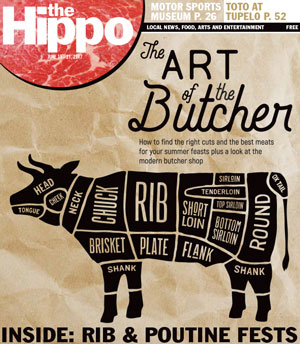FEATURED HEADLINES
Food: The Art of The Butcher Cover Stories *
FEATURED FOOD - * COVER STORIES *
Being A Butcher
How The Profession Has Evolved
Written By Kelly Sennott (ksennott@hippopress.com)
Images: Stock Photo
New Hampshire butcher shops with meat hanging from the ceiling are history, said Billy Steeves, manager at the Prime Butcher in Hampstead. Instead, butchers today are kind of like curators, presenting quality beef, chicken and pork in the best way.
Becoming a Butcher
Historically butchery was something you’d learn via an apprenticeship, but today people enter the vocation through many different doors.
Some jump in because it’s a family business; the Prime Butcher, for example, is a fourth-generation enterprise, owned by Steve George Jr. (His father, Steve George Sr., owns the Prime Butcher in Windham, and his uncle, Christopher George, owns Mr. Steer Meats in Londonderry.) Steeves has a culinary background, having studied at Johnson & Wales University and worked at a restaurant before starting in Hampstead about seven years ago.
Rob Darling, co-owner of Concord Beef and Seafood, said his butchery education happened while he was working in the seafood department at Dole & Bailey in Woburn, Mass. There, he befriended the “meat guys” before starting his Concord business with Al Smith and Michael Souffron 13 years ago.
“I was lucky enough to work for a place where they’d let me wander into the cutting room, poke around and ask a ton of questions,” Darling said.
Goodbye to Rocky
In New Hampshire butcher shops, chances are good you won’t find animal parts hanging from the ceilings anymore — it’s not like Rocky, said Steeves.
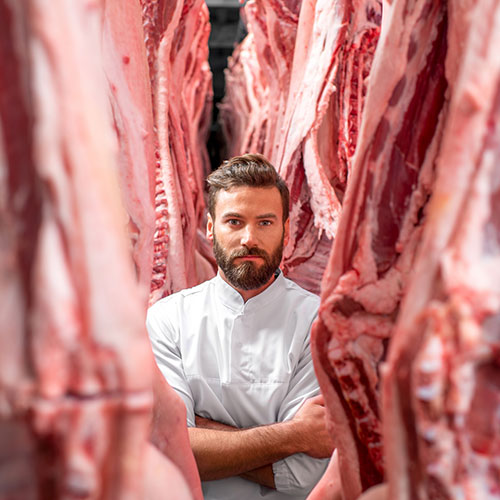
Butchers are no longer taking meat straight from the animal and preparing it for customers. Since the ’70s and ’80s, most local shops work from boxed meat ordered from western or midwestern processing facilities, vacuum-sealed shut until ready to be cut and sold.
“This way, not a scrap of the animal is wasted. The big meat companies, they get to make money off every little part they’re processing. With the individual butcher, we get just the parts we want. We’re not paying for the whole weight,” Darling said. (Plus, they don’t have to fill their cooler with a whole cow.)
People who do butchery work — slaughtering and processing meat — do exist in New Hampshire (for example, there’s Lemay & Sons in Goffstown) but they’re few and far between.
“It’s not really butchery anymore — what the actual job is is what they call meat cutting. If I were to hire somebody coming in off the street, they wouldn’t apply for a butcher’s job. They would apply for a meat cutter’s job,” Steeves said.
Day-to-Day
“The art in what I do now is managing the business, which is the most challenging thing, because in the last five years beef prices have gone crazy, whether it’s because of the drought or the demand for beef rising overseas. It’s an expensive product,” Darling said.
Attention to detail is important in today’s butcheries. Customers expect meat to be pristine, and so Steeves said many man-hours go into trimming, tenderizing and marinating (via a vacuum tumbler, which marinates meats fast). There’s lots of back-and-forth between vendors, with the goal of selling only the best, free of hormones.
“Generally, grocery stores cater to the masses. We cater to people who are looking for something a little better, higher-quality. We deal exclusively with upper choice and prime grade meat,” Steeves said.
But the stuff is expensive, and so running a butcher shop also means strategizing how much to buy and when to put it out.
“Once you break the seal, time is ticking. The beef is going to start to brown; you want to sell that within a day. We have super-tight controls over how many steaks are on the tray and when they’re open,” Darling said.
Steeves said the Prime Butcher also offers cooking tips to customers.
“Christmas is huge because a lot of people do prime rib — but they’ve never cooked prime rib. Or turkey. So I actually spend a lot of my days Christmas week with a Sharpie writing those directions right on the packaging,” he said.
Community Shops
Probably most characteristic of these butcher shops is their small-town feel.
“There’s definitely a community aspect to a butcher shop, which you don’t always get in a grocery store,” Darling said. “If you know the guy behind the counter, you know you’re
not getting five-day-old beef. When you’re buying food, you want to be confident in the food you’re buying, especially if it’s something expensive like beef or fish. … And as a butcher shop, we need the support of the community. We can’t have people come in just once in a while.”
Steeves said he knows many customers by their name or regular order.
“You have to really like dealing with customers. A lot of our customers we see five times a week. … This is a small town. Everybody who’s driving, coming home from work, will stop in and say, ‘What looks good tonight?’” Steeves said. “It’s the same people, night in, night out, week in, week out. It’s cool. They get to know you, and you get to know them.”
Beefed Up
Cuts from the Cow & How to Prepare Them
Written By Matt Ingersol (listings@hippopress.com)
Images: Courtesy/Stock Photo
From hamburgers to London broil steak, filet mignon to jerky, the meat from a cow provides dozens of variations of flavor and tenderness. Local butchers say these differences have mostly to do with the animal’s muscle usage in its body.
“The muscles that the cow uses the most [to move around] often produce the tougher cuts, so those in turn require a longer and slower process of cooking,” said Craig Muccini, owner and general manager at The Flying Butcher in Amherst. “So you want to braise cuts from the leg and shoulder muscles, because they are worked hard, whereas something like a beef brisket you would want to put on a smoker.”
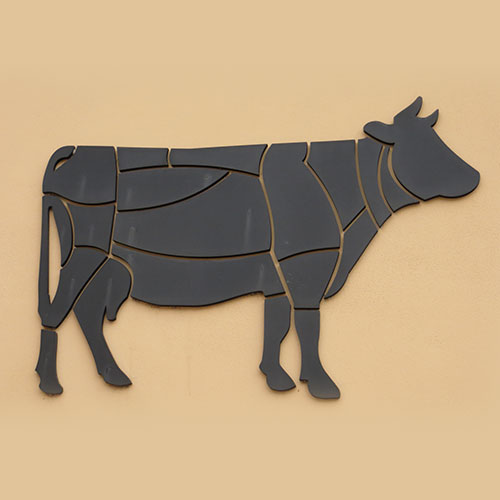
Kyle Perreault, a butcher at Mr. Steer Meats & More in Londonderry, said shoulder clods of beef are great for hamburgers because the meat is usually very lean.
Burger patties are prepared at Mr. Steer using a Hollymatic Super Patty machine. Owner Christopher George said patties are available either as singles through the front case or frozen in 4-ounce or 6-ounce boxes.
“You don’t want to have the meat too lean, because the leaner you make it, the drier it is,” George said. “Between 85 and 90 percent lean is usually a good mark.”
The chuck, a rectangular piece coming from parts of the cow’s shoulder and neck bones, is a cut Perreault recommends slow cooking for a period of time in a crockpot or a pot, due to its fat content.
“Once you get farther down the chuck [on the animal’s body], you get to the short ribs and loins, which are awesome for braising,” Perreault said. “The short loin is also where you get your Porterhouse and T-Bone steaks, and the filet mignon actually comes off of the short loin as well. … The reason a filet is so tender and has very little fat is because there is really no movement; it’s all on the inside.”
Muccini said chuck and short rib cuts are usually not the best to grill because they generally aren’t as tender.
“Tenderness and flavor are a little bit separate from each other,” he said. “You’re not going to be able to [grill] chuck steak cuts for 10 or 12 minutes … and expect to serve it tender as a [short loin] steak.”
Other cuts include the flank and the brisket, which are located in the cow’s chest area.
“The brisket … is a little bit of a fattier piece,” Perreault said. “That’s good for smoking and for slow cooking, and then farther down, where there’s less rib and a little less movement, you have the flank and the skirt, and those are good for grilling.”
Along the hindquarter and back leg areas of the cow, cuts are divided into the top round, bottom round and eye round, located in the center. Below the round is the shank, a tender cut just above the leg bone. Perreault said a lack of fat in these cuts makes for good roasts, and the round cuts are also often used to make beef jerky.
Muccini said some cuts that are not as widely available but can be special ordered include beef cheeks, or the meat from the facial muscles of the cow, and hanger steak, which comes from the animal’s diaphragm area, as well as inner organs like the liver and the kidneys.
“We can’t sell them regularly all the time but we can always order it fresh for the customer,” he said.
As for what you’ll pay, ground beef is going to be cheaper than some of the other bigger steak cuts; depending on how lean it is, it’ll go for around $5.99 or $6.99 per pound.
Briskets are also at about $6.99 per pound. Ribeyes can go for around $15 to $16.99 per pound. Tenderloin steaks like filet mignon and short loin are pricier at about $24.99 per pound.
“Basically the more tender or flavorful it is, the more you are going to pay for it,” he said.
Beyond Beef
How & Why To Pick Another Protein
Written By Angie Sykeny (asykeny@hippopress.com)
Images: Stock Photo
If you’re looking for meats other than beef, butcher shops have plenty of options. Here are some options, plus tips from local butchers about how to turn them into a delicious meal.
Chicken
A chicken may be small, but it offers a variety when it comes to cuts. Most cuts above the belly, such as chicken breast, tenderloin and wings, are the white meat, while cuts below the belly, such as the drumsticks and thighs, constitute the dark meat.
“There’s a little bit of a different flavoring,” said Moe Duncan, meat department manager at Quality Cash Market in Concord. “Typically, the darker meat is a little more on the dryer side where the breasts typically have more juice to them.”
There are all kinds of ways to cook chicken; baking, broiling, deep frying and grilling are some of the most common ones. Baking is the easiest, Duncan said, because you can “set it and forget it,” whereas a method like deep frying requires more steps and preparation because of the oil and batter involved. Mainly, it’s about personal preference.
“It comes down to how creative someone wants to be and how much time they’re willing to put into cooking,” Duncan said.

The key thing to remember when cooking chicken is to make sure it’s cooked thoroughly. Use a thermometer, Duncan said, and keep it between 160 and 170 degrees. (The FDA website recommends that all chicken should be cooked to 165 degrees). Different cuts may require more time to cook than others, but Duncan said it’s easy to figure out once you’ve done it a couple times.
“You can’t say how long [to cook it] because it really depends on the size and the weight of the meat, and on the type of oven you have,” he said “It’s a learn-by-trial-and-error thing. You’ll learn over time how long it takes to cook a chicken breast versus a chicken leg.”
Lamb
Cuts of lamb meat can include lamb chops, rack, shank and leg and can be cut into smaller pieces and used for kabobs, stews and other dishes. Some cuts are fattier than others and can produce an excessive amount of grease if not cut properly.
“A good piece will keep just a thin layer of fat on the edge so you don’t burn the meat, but it will have a dryer feel to it,” Duncan said. “Otherwise, if it’s not cut right, you’ll get a very greasy meat, and you’ll only taste the grease and the fat, not the meat itself.”
While lamb meat doesn’t have a lot of flavor on its own, it is a great conductor of added flavors and seasonings, so it’s better to season too little than too much.
“You want to keep it light and simple,” Duncan said. “Stick to things like garlic and rosemary and maybe salt, but a very small amount.”
Pork
Pork includes a variety of cuts from a pig, such as pork chops, loin, roast, tenderloin and ribs. Ham, bacon and sausage also fall into the pork category.
Different cuts carry different flavors and textures.
“It depends where on the line you’re cutting [the meat],” Duncan said. “The pork chops in the center cut — that’s the sweet side. The fat on the edge gives it a sweet flavor, whereas tenderloin is a leaner piece of meat, so it has a more dry taste to it, but it’s still moist enough that it comes apart when you eat it.”
There is also more flavor in a pork cut with the bone in than there is in a boneless cut, Duncan said, because the bone marrow, when cooked, adds flavor and moisture to the meat.
Ribs are most commonly grilled and covered in a sweet or spicy barbecue sauce or seasoning. For pork chops and roasts, however, Duncan recommends baking or pan frying and going light with the seasoning.
“Keep it simple,” he said. “You want a little seasoning and flavor, but you don’t want it to overbear the meat. If you’re going to spend the money on the meat, you want to be able to taste it and enjoy the real flavor of what you’re eating.”
Venison & Buffalo
If you’re looking for a healthier alternative to beef, venison and buffalo are good options. You can do venison or buffalo burgers, steak, tacos, chili — basically anything that you can do with beef, but with a much lower fat content.
“[Buffalo is] very similar to beef,” said Brian Farmer, owner of Yankee Farmer’s Market in Warner, which offers buffalo and venison among its selection of meats. “A lot of people wouldn’t notice the difference, other than the lack of fat. They’d just say, ‘Oh, this is a great steak!’”
Farm-raised venison is also similar to beef, except that cuts of venison meat tend to be a bit smaller. Wild venison, however, doesn’t have the controlled diet that farm-raised venison does, resulting in a stronger gamy flavor.
Since there is little fat in venison and buffalo meat, they’re quick and easy to cook; meat is more dense than fat, Farmer said, so it’s better at holding in heat.
“You have to train yourself not to overcook it and to [stop cooking] when it’s a little too rare, because by the time you get it on the table, it will be just about perfect,” he said.
“Worst-case scenario, you [cook it] for a couple more minutes.”
Soak it In
How Specialty Marinades Can Make your Protein Pop
Written By Ryan Lessard (news@hippopress.com)
Images: Stock Photo
Specialty marinades can take a so-so dish and turn it into a delicious dinner.
Amy LaBelle, winemaker at LaBelle Winery in Amherst, says marinades serve two purposes: they soften the meat and improve its flavor. “Marinating is a way to elevate especially a tougher cut of meat,” LaBelle said. LaBelle sells a spice blend that, when mixed with olive oil and wine, serves as a marinade. She says wine is an acid between 3 and 4 pH, which helps with the softening process.
There are dry citrus peels in her spice blend, which is also acidic.
“And that is going to soften the fibers in the meat. So you’re all at once flavoring and softening, which is going to create a much better dining experience,” LaBelle said.
She said cooking with wine is very common in French cuisine.
“I lean toward French cuisine. I love French cuisine. I love the flavors in French cooking, but these spice blends that turn into marinade with the addition of wine and olive oil are really, I think, boldly American,” LaBelle said. In addition to making wine, LaBelle loves to cook, so she says creating a spice mix and marinade under “The Winemaker’s Kitchen” label was a natural evolution.
“We’re considering doing the marinade as a pre-done bottle soon, but I like the fact that you can use the spice blend in many different ways,” LaBelle said. She sells three different spice blends designed to work with different proteins. One is for steak, one is used on pork and poultry and the last is for fish.
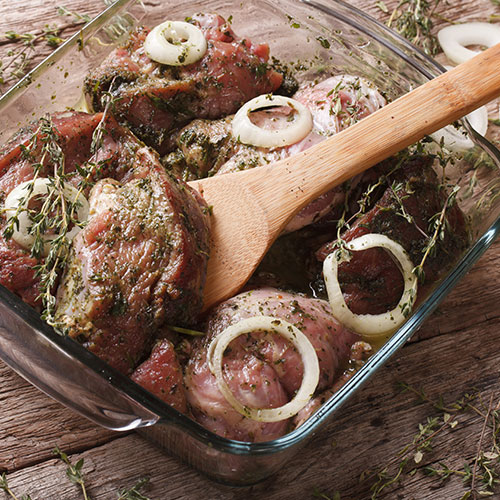
For the steak marinade mix, she recommends mixing the spices with a red wine. The poultry mix works best with a white wine or the apple wine LaBelle makes with New Hampshire apples. For the fish marinade, she recommends a riesling or a seyval blanc.
“The seyval blanc, in particular, is beautiful as a fish marinade because it itself has a lot of citrus tones,” LaBelle said.
Since she currently sells the spice blend separately, she said it can also be used as a rub or ground in a coffee grinder to create a super-fine “dusting agent.”
“It makes the product more versatile,” LaBelle said.
One of the advantages of using her marinade blend and locally made wine is the lack of additives in both. “For us, you’ve got the confidence of knowing … there’s no chemicals in the bottle,” LaBelle said.
At The Tuckaway Tavern and Butchery in Raymond, general manager Bobby Marcotte said all their Tuckaway brand marinades are gluten-free.
Both LaBelle and Marcotte agree that grocery store marinades are usually either too salty or too sweet.
“It comes down to flavor, right? When you’re customizing and you’re coming up with flavors that you want to produce, you can really dial it in. Whereas I feel a lot of the stuff you buy in the grocery store is going to be one-tone, either sugar or salt,” Marcotte said.
Tuckaway offers a variety of marinades, from teriyaki and Buffalo to its popular house blend. Marcotte said the house blend was actually a recipe carried on from the Yankee Freetown Market, an old butcher shop that used to be in the same building.
“Our house [blend] is obviously our most popular, so we try to keep that really as a stand-alone,” Marcotte said. “It’s really your standard Italian marinade but we kind of elevate the seasonings a little bit — elevate the garlic, elevate the pepper [to] make it really hit you in the mouth when you eat it.”
While Marcotte said the house blend is savory, the second favorite is the opposite. The Fat Boy marinade is made with corn syrup, molasses, ginger and brown sugar.
“Our most popular proteins are definitely our steak tips [and] our No. 2 seller for steak tips would be our Fat Boy marinade, which is sweet and sticky,” Marcotte said.
Local Buteries
Brothers Butcher (8 Spit Brook Road, Nashua, 809-4180, brothers-butcher.com) is a family-owned and -operated butcher shop offering steak and chicken marinades, roasts, pork, sausages, stuffed chicken breasts and other specialty meats that include ground sirloin and beef short ribs. Selections are priced per pound and range from $3.99 to $24.99 depending on the type of meat. It’s open Monday through Friday, 9 a.m. to 7 p.m., and Saturday and Sunday 9 a.m. to 5 p.m.
Campania Market (290 Derry Road, No. 12, Hudson, 880-8300, campaniamarket.net) is a family-owned Italian market with an in-house butcher shop, offering deli meats, homemade sausages and marinated chicken products. The market also offers a line of hand-cut steaks using premium Angus beef. Meats prepared in the butcher shop are used in platters, calzones and pizzas and more available at the market at varying prices. It’s open Tuesday through Saturday, 10 a.m. to 7 p.m., and Sunday 10 a.m. to 5 p.m.
Choice Cuts Butcher Shop & More (707 Milford Road, Merrimack, 718-1262, facebook.com/choicecutsbutchershop) sells locally made grass-fed meat products like marinated steak and chicken, prime rib tenderloin and more. Prices are by the pound and vary depending on the type of meat. It’s open Monday 11 a.m. to 6 p.m., Tuesday 9 a.m. to 6 p.m., Thursday through Saturday 9 a.m. to 7 p.m. and Sunday 9 a.m. to 6 p.m.
Concord Beef & Seafood (79 S. Main St., Concord, 226-3474, concordbeefandseafood.com) is a premium butcher and seafood market offering seafood straight from the Boston Fish Pier, as well as Chairman’s Reserve premium beef and Bell & Evans brand fresh chicken. It’s open Monday through Friday, 10 a.m. to 6:30 p.m., Saturday 10 a.m. to 6 p.m. and Sunday 10 a.m. to 4 p.m.
The Flying Butcher (124 Route 101A, Amherst, 598-6328, theflyingbutcher.com) offers several meat cuts, including prime beef, marinated steak tips, pork, sausage, and seafood, poultry and lamb options. There is also an in-house deli featuring Boar’s Head products, and products provided by local vendors that include fresh produce, toffee, milk, eggs, cheeses and more. Costs of meats range from $5.99 to $24.99 per pound depending on the type of cut. It’s open seven days a week from 9 a.m. to 7 p.m.
The Happy Butchers (222 Elm St., Milford, 554-1339, thehappybutchers.com) has a vast meat selection that includes 1855 Black Angus Beef and Springer Mountain all natural chicken, as well as other meats by the pound like pulled pork, smoked brisket, spare ribs and baby back ribs, pulled chicken and more. Prices range from $7.99 to $24.99 per pound. It’s open Tuesday and Wednesday, 9 a.m. to 6 p.m., Thursday through Saturday, 9 a.m. to 7 p.m., and Sunday, noon to 6 p.m.
The Healthy Buffalo (258 Dover Road, Chichester, 369-3611, healthybuffalo.com) offers specialty meats that include buffalo, ostrich, wild boar, alligator, elk, kangaroo, rabbit and more. Special orders can be made by visiting the store or filling out an order form online. Prices vary depending on the type of meat, the type of cut and the quantity. It’s open Monday through Friday, noon to 6 p.m., and Saturday and Sunday, 10 a.m. to 4:30 p.m. Entrees using their products are also available at The Hungry Buffalo (58 Route 129, Loudon, 798-3737, hungrybuffalotavern.com), which is open Sunday through Wednesday, 11:30 a.m. to 9 p.m., and Thursday through Saturday, 11:30 a.m. to 11 p.m.
Huntspoint Meat Company (114 Calef Highway, Epping, 679-5700, huntspoint.com) offers a variety of barbecue meats, including beef ribs, Gold Wagyu brisket, Berkshire pork, Hatfield pork and more. Prices vary depending on the different options that are available by weight. It’s open Monday, Tuesday and Thursday, 11:30 a.m. to 7 p.m.; Friday and Saturday, 11:30 a.m. to 7:30 p.m., and Sunday, 11:30 a.m. to 6 p.m.
Joe’s Meat Shoppe (229 Atlantic Ave., North Hampton, 964-6152, joesmeatshoppe.com) offers a variety of fresh cut meats like 1855 Black Angus Beef, pork, lamb, veal and poultry, as well as a deli featuring Dietz & Watson products. Prices vary depending on the quantity and type of cut, with beef coming as loin, rib, brisket, flank and chuck, pork as chops, tenderloin and roast, and veal as cutlets. It’s open Monday through Friday, 8 a.m. to 6 p.m., and Saturday, 8 a.m. to 5 p.m.
Lemay & Sons Beef (116 Daniel Plummer Road, Goffstown, 622-0022, lemayandsonsbeef-bbq.com) is a family-owned farmers market style butcher shop specializing in pig roasts using rotisserie style barbecue machines. Other products offered include wholesale and retail beef, pork and poultry. Prices vary depending on the type of meat. It’s open Monday through Friday, 8 a.m. to 6 p.m., and Saturday, 8 a.m. to noon.
Local Provisions (622 Main St., Laconia, 527-8244, localprovisionsnh.com) is a chef-owned butcher shop offering a variety of beef products like rib-eye steaks, sirloin steaks, filets and short ribs, as well as poultry and pork products, dozens of seafood options, veal and lamb chops and shanks, and special order meats that include rabbit, goat, duck, quail, pheasant, elk and more. All products are sourced from farms in New Hampshire and Maine, like Berkshire Farm in Gilford and Meadow View Farm in Gilmanton. It’s open Wednesday through Saturday, 11 a.m. to 6 p.m., and Sunday, 11 a.m. to 4 p.m.
McKinnon’s Market & Super Butcher Shop (236 N. Broadway, Salem, 894-6328; 2454 Lafayette Road, Portsmouth, 559-5714, mckinnonsmarket.com) offers a variety of fresh meats that include Italian sausages, spare ribs, sirloin patties, beef sirloin steak, seafood and more. It also includes an in-house deli and supermarket, with weekly specials on its products available in the store and online. The Salem store is open Monday through Saturday, 8 a.m. to 8 p.m., and Sunday, 8 a.m. to 7 p.m. The Portsmouth store is open Sunday through Wednesday, 8 a.m. to 8 p.m., and Thursday through Saturday, 8 a.m. to 9 p.m.
Mr. Steer Meats & More (27 Buttrick Road, Londonderry, 434-1444, mrsteermeats.com) is a butcher shop and in-house deli that has been in business for four generations dating back to the early 1900s. Products include several different cuts of USDA prime and choice Angus beef, pork tenderloins, baby back ribs, filet mignon, veal cutlets, chops and shanks, and hamburgers to grill yourself. The deli includes Boar’s Head meats, freshly made soups and a serve-it-yourself salad bar. Mr. Steer is open Monday through Friday, 8 a.m. to 6:30 p.m.; Saturday, 8 a.m. to 6 p.m., and Sunday, 8 a.m. to 4 p.m.
The Prime Butcher (201 Route 111, Hampstead, 329-7355; 58 Range Road, Windham, 893-2750, primebutcher.com) offers more than a dozen types of beef cuts like flat cut brisket, filet mignon, Porterhouse steak, fresh ground beef, London broil steak and skirt steak. Other meats available are pork ribs and chops, chicken breasts, cutlets and legs, lamb chops, sausages and more. Specialty cuts include stuffed pork roasts, stuffed pork chops, stuffed chicken breasts, and an Al Capone roast made with prosciutto, pepperoni, provolone cheese and mushrooms stuffed inside of a flank steak. The Hampstead shop is open Monday through Friday, 9:30 a.m. to 6 p.m.; Saturday, 9 a.m. to 5 p.m., and Sunday 10 a.m. to 2 p.m. The Windham shop is open Monday through Friday, 9 a.m. to 6 p.m.; Saturday, 9 a.m. to 5 p.m., and Sunday, 10 a.m. to 2 p.m.
Quality Cash Market (11 Eastman St., Concord, 225-9661, qualitycashmarket.com) has an in-house butcher shop offering marinated steaks, steak tips, chicken and more. It’s open Monday through Friday, 7 a.m. to 7 p.m.; Saturday, 8 a.m. to 7 p.m., and Sunday, 8 a.m. to 6 p.m.
The Tuckaway Tavern & Butchery (58 Route 27, Raymond, 244-2431, thetuckaway.com) offers more than 20 types of handmade sausages and burgers, made fresh daily. There are also marinated chicken tenders, rib-eye and strip steaks, filet mignon, bison tips, pork and more. Other products include homemade chicken salads, desserts, potato salad and pot pies. Prices vary depending on the type and quantity of meat. The butchery is open from 9:30 a.m. to 7 p.m. seven days a week.
Wicked Good Butchah (460 Route 101, Bedford, 488-1832, wickedgoodbutchah.com) offers a variety of meat products, including different cuts of poultry, beef, lamb, pork, sausages and seafood. An in-house deli with Boar’s Head products, prepared foods and fresh baked breads is also available. It’s open Monday through Saturday, 10 a.m. to 7 p.m., and Sunday, 10 a.m. to 6 p.m.
The Wine’ing Butcher (254 Wallace Road, Bedford, 488-5519; 28 Weirs Road, Gilford, 293-4670; 81 Route 25, Meredith, 279-0300; 16 Sheep Davis Road, Pembroke, 856-8855, wineingbutchernh.com) offers USDA prime and choice cut beef, ribs, roasts, chicken wings and breasts and more. A selection of its signature marinades and spice mixes is also available, in addition to a in-house deli offering Boar’s Head products, craft beers and cheeses. The Bedford and Pembroke shops are both open Monday through Saturday, 10 a.m. to 7 p.m., and Sunday, 10 a.m. to 6 p.m. The Gilford shop is open Monday through Saturday, 10 a.m. to 7 p.m., and Sunday, 10 a.m. to 5 p.m. The Meredith shop is open Monday through Saturday, 10 a.m. to 7 p.m., and Sunday, 9 a.m. to 5 p.m.
News: Less Staff at Women’s Prison
FEATURED NEWS
Less Staff at Women’s Prison
How the Current Senate Budget Could Affect Staffing
Written By Ryan Lessard (news@hippopress.com)
Images: Stock Photo
Earlier this year, Republican Gov. Chris Sununu proposed a budget that would have funded operations at the new women’s prison in Concord — due to complete construction this fall — to the tune of $48.7 million in fiscal year 2018 and $49.8 million in 2019. That would have been enough to fully staff the prison, according to the state Department of Corrections, but the legislature had different ideas that will mean less staff at the prison.
Budget Talks
On May 31, the GOP-led Senate passed its version of the state budget along party lines and Democrats voiced their dissent in public statements. Some, like Democratic Minority Leader Jeff Woodburn, said the budget creates an artificial surplus from unspent revenues to support the “ruse” that cutting taxes for the rich will grow revenues. Many pointed to things left out of the budget, like full-day kindergarten spending. But some of those are being addressed in separate legislation.
What the initial comments largely didn’t address was funding for the women’s prison, which was lowered from the governor’s proposal by the House budget that failed to pass and then further lowered by the Senate. Almost $2 million was cut from the governor’s 2019 budget for the prison.
Usually, the Senate spends more than the House, due to its traditionally higher revenue estimates. This year, that didn’t happen.
Democratic Sen. Lou D’Allesandro of Manchester said Republicans in the Ways and Means Committee lowballed revenues, which he called “very unusual.”
“I think we had $20 million more to work with,” D’Allesandro said. “If you look at the economic signs, they were all good. We have a very low unemployment rate, our business taxes are producing significant revenue, real estate transfer tax is good. … I cannot explain it.”
As a result, prison spending went down.
How lawmakers arrived at their revenue numbers is unclear, but there’s disagreement between House and Senate Republicans. Reached by phone June 13 during a break in budget talks, Republican Rep. Kenneth Weyler, who serves on the House Finance Committee, said reconciling that difference was still a challenge.
“The last we heard, there’s still about a $40 million gap,” Weyler said.
Staffing
Originally, the DOC had planned to increase staff from the 40 or so currently working at the Goffstown women’s prison to about 117 by 2019 at the new prison. The new prison is twice the size of the old one and, once it’s built, DOC plans to move the women in Goffstown, plus the women at Strafford County Jail and at the Shea Farm Transitional Housing
Unit in Concord, and the women they had to place out of state.
“We need the staffing to make sure it’s run in a safe and secure way,” said DOC spokesman Jeff Lyons.

He said when the House was drafting its budget, it had abolished about 20 nurse and correctional officer positions at the women’s prison. By the time it reached the Senate, budget writers appeared poised to do the same.
“We were able to convince the Senate not to abolish them but to unfund them. Basically, what that means is we won’t have access to them during the coming biennium but the positions aren’t entirely lost,” Lyons said.
For this biennium, the effect is about the same — 20 fewer employees to provide medical care and ensure inmate safety — but keeping them in the budget will make it easier to lobby for funding in the 2020-2021 budget.
Weyler said the reduction in staff is based on the move to Concord being delayed and pointed to the request to extend the lease in Goffstown as evidence of that. He said it’s possible the new prison won’t be open until the next calendar year, so funding staff in the first fiscal year of this budget is not pressing.
“Eventually, we will hire those people,” Weyler said.
Lyons concedes that even if the DOC had the funding they asked for by the time they start moving inmates, they aren’t likely to have those positions filled.
“All along, we’ve been having difficulty filling positions in the first place. So even if the [requested] budget was approved, we still can’t begin hiring until the beginning of the fiscal year,” Lyons said.
While the prison facility is due to be ready by October, training corrections staff takes several weeks. Lyons said he can’t give a firm date for launch of operations at the prison.
In the interim, having less staff will mean spending more on overtime, Lyons said. But there is a larger issue here: providing women with the same services male inmates get. That was the decades-old legal issue that led to the women’s prison in the first place.
“The original intent behind the lawsuit that was filed … was that the women need to have parity with the males,” Lyons said.
For D’Allesandro, that should make this project a priority.
“The prison’s completion date had to be moved up because they needed more money to finish it, so it’s been a challenge all along and we should be doing it right,” D’Allesandro said.
Arts: Curious Magic
FEATURED ARTS
Curious Magic
Currier Hosts Exhibition Featuring NH Artist Varujan Boghosian
Written By Kelly Sennott (ksennott@hippopress.com)
Images: Courtesy Photo
Hanover artist Varujan Boghosian is very pleased with the show Currier Museum of Art curator Kurt Sundstrom put together — “The Curious Magic of Varujan Boghosian,” on view June 10 through Sept. 4.
“You’ve done a wonderful job, covering a whole range,” Boghosian, now 92, told Sundstrom during a walk-through days before the opening; he’d driven almost an hour and a half that rainy day to inspect the comprehensive 60-piece show, and while he did skirt around the space with his cane to scratch in some corrections, he understood Sundstrom had no easy task. “I’ve had a retrospective, and many other shows, but this one is loaded! It covers a big range, from early watercolors to constructions to collages to recent work.”
The exhibition draws from the artist’s collection, the Currier’s holdings and private collections, and it contains all sorts of work — paintings, drawings, surrealist collages and assembled sculptures made of found objects, which are rich in references to art, mythology and literature. Some pieces date back to the 1950s, and some are brand new.
“We really tried to bring a full representation of all the work he’s done. Watercolor, clay, drawings,” Sundstrom said. “One thing that’s hard about this is that you have to talk about surrealist things, but you don’t want to over-explain it, because then it’s no longer surrealist. Surrealist art should [consider] each individual’s own interpretation [with] equal validity. You have to give just enough information. … He’s probably the leading surrealist artist, anywhere. He just had a show in Paris.” (“The French love me,” Boghosian piped in.)

Boghosian, the son of Armenian immigrants, was born in New Britain, Conn., in 1926. After serving in the Navy during World War II, he studied in Italy on a Fulbright Scholarship, then under Josef Albers at Yale School of Art and Architecture. Between 1963 and 1966, he exhibited in New York at the Stable Gallery at the same time as renowned artist Andy Warhol before moving to New Hampshire in 1968 to teach at Dartmouth College, which he did for nearly 30 years.
Boghosian said he loves the Upper Valley’s fresh air, solitude and camaraderie; it’s home to so many creative people, including collage artists Marcus Ratliff, David Powell and Soo Sunny Park, whose “BioLath” exhibition is in the Currier the next gallery over. The region’s also perfect for collecting, which he does most every day. One of his favorite sites is the Antiques Collaborative in Quechee, Vermont.
“I’m not inspired. I just work,” Boghosian said. “However, if I find something special as I’m looking around, that’s always exciting. You know: a three-dimensional object, a strange, rare piece of paper I can work with. Those are exciting finds. It’s like a gold mine out there.”
It’s been more than 60 years since he began collecting items for his collages, but he still can’t say what it is that draws him to an item. He just knows.
“That’s the very key question! The working process is intuitive, accidental and calculated. … I’ve been doing it so long that when I walk into a space where there are objects for sale, I almost immediately know what I might be able to use in my work,” said Boghosian, who was particularly happy about some recent additions to his collection — a book on Salvador Dali, a Spanish surrealist artist he admires, and a primitive slingshot he thinks would be great for a David and Goliath-themed piece.
At the time, he was preparing a presentation at the museum, which happened June 11. His goal, as always, was to be funny, not boring.
“When I ended my classes, I said, ‘You will never remember anything I have said. And I don’t think I’ve said anything here!’ … As a teacher, you talk a lot, but I’ll try not to be boring. I enjoy a nice dialogue,” said Boghosian, who noted that he recently began re-reading Death in Venice by Thomas Mann and finds it a bit excessive. “I’m at the point now where I just like to read the summary, you know? … That’s why some of these [collages] only have two elements. We’ve done away with the superfluous and gotten down to rock-bottom.”
Alongside each piece is text to give you hints at his references. Many tell of the tragic love story of Orpheus and Eurydice, but sprinkled in are homages to prose by Franz Kafka and James Joyce, poetry by Blake and Dickinson. Many make direct references to famous artists. The most playful pieces are his “tchotchkies,” sculptures that bring together two seemingly different objects to create new meaning. (For example, a top pinned to a globe translates to “top of the world.”)
The Currier last hosted a Boghosian retrospective under Mac Doty, director of the museum from 1977 to 1987, but staff liked the idea of bringing the local artist back to Manchester because of his long ties to the Currier; he taught there in the late ’50s.
“But he’s also a really nice guy,” said Sundstrom, who added that many artists work as long as Boghosian, but not all create new work the whole time. “A lot of them just repeat what they did that got them famous 50 or 60 years ago. He’s exploring this whole new thing.”
Related Events
Creative Studio: Name Assemblage Saturday, July 8, from 10 a.m. to 1 p.m.; explore the work of Varujan Boghosian and make your own assemblage with found objects, for adults and children; free admission this day for NH residents from 10 a.m. to noon
Currier After Hours: Common Objects Reimagined Thursday, Aug. 3, from 6 to 9 p.m., celebrating NH artist Varujan Boghosian, with art-making activity, plus tour of the exhibition with curator Kurt Sundstrom, live music, food
Creative Studio: Pun Making Saturday, Aug. 12, from 10 a.m. to 1 p.m., explore visual puns and smart juxtapositions in “The Curious Magic of Varujan Boghosian,” for adults and children; free admission this day for NH residents from 10 a.m. to noon
“The Curious Magic of Varujan Boghosian”
Where: Currier Museum of Art, 150 Ash St., Manchester
When: June 10 through Sept. 4
Admission: $15 for adults, $13 for seniors, $10 for students, $5 for youth, free for children 13 and younger
Contact: currier.org, 669-6144
Music: Hit Machine
FEATURED MUSIC
Hit Machine
Toto Tour Taps Tupelo
Written By Michael Witthaus (music@hippopress.com)
Images: Courtesy/Stock Photo
Despite decades of success, Toto is the Rodney Dangerfield of rock. The late comedian famously complained, “I don’t get no respect at all,” and Toto guitarist Steve Lukather knows what he meant.
“There has been, from day one, people trying to stop us,” Lukather said by phone from his home in Southern California. “We’ve been running up a vertical mountain for 40 years, while we quietly sold 40 million records — and it would have been twice that, believe me. Even our own record company didn’t like us. It was very strange.”
Lukather speaks with clear humor, absent of bitterness. Sober for eight years, he’s having more fun than ever playing with the band he began in high school that went on to score mega-hits with “Hold the Line,” “Rosanna,” “Africa,” “99” and others.
“It’s lightening up now,” he said of the lack of respect. “I mean, there will always be the guys from Rolling Stone, the 70-year-old men stuffed into a Ramones T-shirt who just hate us. I’m never going to change that … so I’m really enjoying the ride.”

He’s not above making a few of his own jabs. Take the band’s name, a Latin term used by Jeff Porcaro and David Paich to note the group members’ deep resumes. It translates to “all-encompassing,” but Lukather learned from fellow musician Tom Scott that it had another meaning.
“I wanted to keep the high school name, Still Life,” Lukather said, “but they started writing ‘Toto’ on all the boxes of demos that we were doing — it just stuck, man! Then we come to find out it’s the biggest toilet company in the world. I said, ‘See guys? You wouldn’t listen to me.’”
In 2007, Lukather walked away from the group with a message posted on his website.
“There is no more Toto,” he wrote at the time. “At 50 years old I wanted to start over and give it one last try on my own.”
When bassist Mike Porcaro fell ill with ALS a few years later, Lukather had a change of heart. Paitch asked him to take part in a benefit and he agreed — provided vocalist Joseph Williams and Steve Porcaro rejoined. The 2010 one-off turned into a tour.
“We went out and had such a great time,” Lukather said. “Joe was bringing it, everything was really fun, so we decided to do it the next year. As we started to get into year No. 3, things got interesting.”
In 2014, they recorded a live album, followed the next year by Toto XIV, the band’s first studio album in nine years. It’s also one of their best, featuring the radio-friendly “Running Out of Time” and “21st Century Blues” a Lukather/Williams co-write that’s a clear homage to one of his favorite bands.
“The running joke was that I always wanted to be in Steely Dan,” Lukather said. “We were basically a Steely Dan tribute band in high school, and Jeff Porcaro was their drummer. ... They and The Beatles were probably our biggest influences, with Jimi Hendrix thrown in for good measure.”
Lukather played on countless sessions in the 1970s and 1980s, with credits on scores of albums. His days as a hired gun ended 25 years ago, though.
“I was taught [that] the life of a studio guitar player is probably about 10 to 12 years,” he said. “You work up from starting out to ‘Ever hear this guy?’ to an A-lister. Then you step aside and make room for the next guy.”
The internet disrupted things even more.
“Now the scene is over,” Lukather said. “Guys do sessions from their house, by Skype or FaceTime. They have studios all set up, and people send them files! I used to walk into sessions not knowing who I was going to work with or what kind of music I was going to play. I had to be ready for anything.”
The passage of time has mellowed Lukather — even his band’s name doesn’t bug him anymore.
“Forty years later, it’s not as stupid as it used to be,” he said. “There are a lot of really stupid names out there, but Toto has been very good to me and I embrace it. I’m very thankful and grateful every day. I’m more relaxed. There is something to be said about getting older. I’m not running the races anymore, just doing what I do best, and there are a few people that dig it. I can feed my nine dependants in the 50 percent tax bracket.”
Toto at Tupelo
When: Sunday, June 25, 7 p.m.
Where: New Tupelo Music Hall, 10 A Street, Derry
Tickets: $100 & $125 and up at tupelohall.com
Film: The Mummy
FEATURED FILM
Film Review
The Mummy (PG-13)
Written By Amy Diaz (adiaz@hippopress.com)
Images: Movie Screenshot
Tom Cruise stars in the jumbled heap of stuff that forms The Mummy, the kickoff to the Dark Universe, a, heavy sigh, monster movie cinematic universe.
In ancient Egypt, Princess Ahmanet (Sofia Boutella) was about to lose at game of thrones to her father’s baby son. She killed her father and the baby, and planned to conjure up Set, the god of death, and put him in a human body. But before she could finish the ceremony, priests stopped her and then “mummified” and buried her alive.
When her coffin is unearthed in the present day, this semi-immortal being escapes, sucks the life-force from people to reconstitute herself and continues in her quest to bring forth Set so that … something. I never really saw what Ahmanet has to gain from this science experiment, especially since its success means she takes backset to a god rather than being the big noise herself.
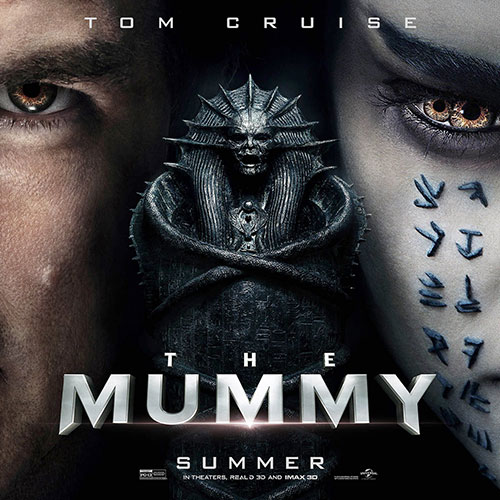
Meanwhile, Nick Morton (Tom Cruise) and his poorly-written comic relief, Chris (Jake Johnson), are U.S. military reconnaissance and, basically, looters. When their looting puts them in the way of insurgents, they call in a U.S. airstrike to get out of trouble.
The bombing uncovers Ahmanet’s tomb, which they explore with Jenny Halsey (Annabelle Wallis), some kind of antiquities investigation person. Since the tomb is in the middle of a war zone, she has the military ship Ahmanet’s coffin to London.
The plane carrying Ahmanet’s coffin and the central cast members crashes shortly before reaching its destination and, though Nick should have died in the crash, he wakes up in the morgue. We hamfistedly learn he has been chosen by Ahmanet to be the vessel for Set’s entry to the human realm. Why him? Because he’s Tom Cruise, and if you’re going to have Tom Cruise in your movie he needs to be in the middle of the action.
We also meet the head of a magical-evil-stuff organization, one Dr. Henry Jekyll (Russell Crowe). Yes, clearly, this movie, which didn’t really know what to do with its one monster (the Mummy), needed to mix in another monster (Jekyll-and-Hyde) to really underline the “part one”-ness of the endeavor.
On the other hand, that this movie is the first in a franchise is the most coherent idea in The Mummy. This movie seems to want Tom Cruise to be an adventurous Indiana Jones type, with some modern anti-hero mixed in and a good supply of funny lines. And the movie is clearly meant to be a mix of action, horror and a smidge of romance. But, as this movie designs those elements, none of them go together. And this is not a “striped sweater and polka dotted skirt” kind of clash, but a “striped sweater, head of lettuce, biology textbook” level of disconnectedness. I feel like I’m watching randomly applied studio notes that The Mummy should be action-packed, be visually exciting, have moments of horror and sell people on the grand mythology. Do them all! In every scene! With a side of Dr. Jekyll!
In addition to not making sense or having much fun, the whole blob drags down Tom Cruise, who is normally great at the actiony, humor-y popcorn flick
Grade: D+
Pop: Back On Tour
FEATURED POP
Back On Tour
Julia Glass on Indie Bookstores, Movies and New Novel
Written By Kelly Sennott (ksennott@hippopress.com)
Images: Courtesy/Stock Photo
Many published authors despise book tours and everything they involve, from air travel and hotel living to events void of readers.
Julia Glass is not one of them. Granted, the Marblehead, Mass., writer’s events probably don’t lack guests; her following has been large ever since she won the National Book Award for Three Junes in 2002. But unlike many writers, Glass is a self-described extrovert. She loves talking to people (and is generous with her time, spending 40 minutes on the phone for this story) and is an enormous fan of indie bookstores.
“One of my favorite things to do is to walk into an independent bookstore … and say, ‘So tell me the things you’ve read lately that I will not have heard about.’ Fewer and fewer books get public attention these days, as newspapers are cutting back on arts coverage,” Glass said via phone. “That’s one thing independent booksellers offer that no online bookstore truly can — [the ability] to look you in the eye, hold out a book to you and say, ‘This is an incredible book that has not been reviewed.’”
Needless to say, Glass looks at promoting A House Among the Trees, published June 13, with anticipation, and the expectation she’ll return home with boxes of new titles.
Glass’s sixth novel is about the unusual bond between world-famous children’s author Mort Lear and his assistant Tommy Daulair. When he dies and unexpectedly leaves her everything, Daulair is honored but dismayed at the complexities of his will and the prospect of dealing with people like the outraged museum curator Lear once promised his artistic estate and the British actor cast to play Lear in a movie.

Unlike most of Glass’s stories, which usually start with a character that pops into her head, this one blended two ideas driven by unusual circumstances. The first one was triggered by a New York Times article about children’s author Maurice Sendak leaving most of his estate to his long-time assistant.
“I thought about having this enormous honor and responsibility bestowed upon you — and at the same time, the judgmental opinions of the world falling on your head,” said Glass, whose research into Sendak’s story ended with that article. “I thought a lot, too, about what it would be like to devote your life to the care and management of someone’s reputation, as well as someone’s career, and then to be left with that ongoing responsibility beyond that person’s death.”
The second part of her idea was inspired by a YouTube video she watched during the 2015 Oscar season featuring Eddie Redmayne, Ethan Hawke, Timothy Spall, Benedict Cumberbatch, Channing Tatum and Michael Keaton.
“What I realized, while these actors were discussing their roles, is that all of them were playing real people. And in some cases, the people were still alive,” she said. “I thought, what if this famous person was about to be played in a biopic? And if that actor had communicated with him and expected to meet him? And when that great writer dies suddenly, he meets with the assistant instead?”
Glass follows theater and film closely thanks to her 21-year-old son, who’s passionate about acting. They see live productions and watch annual awards shows together. Her fascination is usually with the stories, his with the performances, but Glass found enjoyment imagining what it might be like to be an actor.
“[I think] what an actor does is actually quite parallel to what a fiction writer does. … One of the greatest pleasures of fiction is when you fully enter the psyche of a character who’s not like you,” she said.
A House Among the Trees also allowed Glass to dip back into the art world, which she was part of after graduating from Yale in the late ’70s. Her dream was to be a painter, and her first job post-college was in a secretarial position at an art museum. Much of her free time was spent mingling with other artists.
“The art world still fascinates me. ... It’s the path I didn’t follow, and I’m perfectly OK with that,” she said.
When she’s not writing or promoting books, she keeps busy as the Writer in Residence at Emerson College and co-director of a Provincetown arts festival, Twenty Summers, which this year saw big-name novelists like Pulitzer Prize winner Richard Russo.
But one of her favorite things to do is interact with readers, who often give her extraordinary insight into her work — in fact, they sometimes notice themes or nuances she incorporated subconsciously.
“I’ve had people at events tell me what I’m doing [in my writing] that are so true, but I had no idea I [was doing it]. It’s one of the reasons I love going on tour. I love hearing the surprising things people say,” Glass said.
Julia Glass Visits NH
Where: The Music Hall Loft, 131 Congress St., Portsmouth
When: Wednesday, June 21, at 7 p.m.
Admission: $42, includes copy of book, drink, book signing meet-and-greet
Contact: themusichall.org, 436-2400
MORE HEADLINES
Rehab Facility Readies to Close
Rehab Facility Readies to Close
Crotched Mountain Winds Down its Operations
Written By Ryan Lessard (news@hippopress.com)
Images: Courtesy Photo
On June 5, the Crotched Mountain Specialty Hospital began a 90-day process of winding down operations, discharging patients and ultimately closing for good.
Crotched Mountain CEO and President Michael Coughlin said the problems that led to this decision have been building up for over a decade.
“It was an evolving recognition that something needed to happen as far back as 2000,” Coughlin said.
Money Woes
The hospital, which provides long-term rehabilitative services for people with complex medical needs, was bleeding money. Coughlin said that over the past five or six years, the hospital’s reimbursements were not keeping up with its rapidly growing costs, and the organization had to regularly dip into its endowment.
Before that, the board had brought in outside consultants and was approached numerous times with different plans to increase revenue or lower costs. As recently as 2013 and 2014, it tried and failed to strike a deal with larger hospital systems.
“We’re part of a dying breed — organizations that aren’t affiliated with larger hospital systems,” Coughlin said.

While other hospitals joined affiliations, consolidated costs and diversified patients to include better insurers, Crotched Mountain did the opposite.
Coughlin said the hospital was inordinately dependent on Medicaid reimbursements, which he said is the worst payer source aside from no payer source at all.
“We haven’t had an increase in reimbursements for quite a long time, I want to say since 2010, and meanwhile our costs have just been going up and up and up,” he said.
Some of those costs were related to equipment and maintenance, but personnel costs were skyrocketing because of the nursing shortage in the state.
Compared to 2010, he said, the hospital pays “significantly more” for nurses. Crotched Mountain routinely had to hire more outside contract nurses — which costs about 50 percent more than its staff, who are paid about the state average.
“We have to entice people to come from wherever they are up on this mountain in Greenfield, and between the labor costs and the fixed asset costs, it just priced us out of the game, really,” Coughlin said.
Still, Coughlin said, the quality of the work has been top notch.
“This event hasn’t been any reflection of the quality of the work. In fact, all the surveyors who come to us, consultants from around the country come to us and say, ‘You guys are doing amazing work. It’s just that it’s extremely costly,’” he said.
The Opioid Effect
Another thing that’s changed in just the past year has been a shift in the types of patients referred to the hospital.
“Historically, we were the place where people would recover from brain injury, stroke and spinal cord injuries,” Coughlin said.
While the hospital is licensed for 62 beds, it pivoted about two and a half years ago to focus on more severe cases, which reduced their number of patients to about 45. More recently, the census has been about 38 to 40.
But just over the past 12 months, a new type of patient started to show up — who were revived from opioid overdoses.
“What happens is people who are revived from Narcan — people who overdosed, somebody calls 911, first responders show up and they would revive the patient with Narcan — if they’ve been out too long, if … their heart stopped for too long a time, they have a significant rehab that may never heal,” Coughlin said.
A year ago, they didn’t have any of these patients. They now make up about 15 percent of the total referrals.
He said the problem, called anoxic brain injury, happens when the brain is starved of oxygen for too long, often causing paralysis of the arms or legs. In severe cases, it can place people in a coma or a vegetative state.
“The other thing about this population that’s so tragic is they’re young. They’re in their 20s and 30s. It’s people who had an active life and then all of a sudden they make a mistake and their life is ruined. It’s an awful situation,” Coughlin said.
After Lakeview Neurorehabilitation Center in Effingham closed in 2015 amid maltreatment lawsuits and a state review, Crotched Mountain was the last to offer the same kind of specialty services, Coughlin said.
Now, many of these patients will either have to stay at traditional hospitals or nursing homes, or find care in a different state.
Late Bloomer
Late Bloomer
72-Year-Old Music Student Composes “Colors Unseen”
Written By Kelly Sennott (ksennott@hippopress.com)
Images: Stock Photo
Manchester native James Tebbetts signed up for his first flute lesson with the Manchester Community Music School in 2005 at age 59. His motivation: retirement.
“I figured, if I’m going to do something complicated [in retirement], which would be anything with a musical instrument, I’d better start now when I’m still working!” said Tebbetts, now 72, during an interview at the music school.
Tebbetts, who’d been tinkering with the recorder on his own for years, took to music with excitement. After three years of lessons with Aubrie Dionne, he delved into piano and music theory with Justin McCarthy. When he discovered seniors could audit classes for free at Saint Anselm College, he registered for composition courses there and began writing his own music. When he retired from a career in software engineering in 2012, he delved in full-time.
The fruits of his work are on display during a concert, “Colors Unseen,” featuring original compositions by Tebbetts at the Grace Episcopal Church in Manchester, Wednesday, June 21, at 7 p.m. Most performers are MCMS faculty members, including Harel Gietheim (cello), Kyoko Hida-Battaglia (oboe), Jennifer Larson (horn), Debbie Markow (violin), Elliott Markow (viola), Caresse Mailloux (flute), Justin McCarthy (piano) and Greg Newton (bassoon).

It’s the third concert produced with MCMS featuring compositions by Tebbetts. Each event requires a great deal of effort on his part, but the effect is glorious.
“Every dog has his day. That buzz takes a while to generate, but it lasts a while,” Tebbetts said.
Tebbetts had been dreaming about delving into music for ages. As a kid, he remembers feeling awed by the Victory at Sea television series soundtrack, the way the music projected images and told a story through sound. As an adult, he was taken by hearing trumpeter Jay Daly play in downtown Boston in the late ’80s, causing him to purchase a recorder at Ted Herbert’s Music Mart and learn as many songs as he could on his own.
Normally, Tebbetts said, he doesn’t like talking about himself very much, but get him on the topic of music, and he’ll happily chat about music history and theory, and the movements and nuances in his own work. He loves the artistic freedom in composing his own music, and he dreams of someday writing a symphony.
“[As an instrumentalist], you’re adding your own interpretation. Your own expression. How do I think this should be performed? However, you don’t select the notes. You do not define the melody,” Tebbetts said. “If you’re the composer … [you can] portray the image that is exactly in your mind.”
Music School Executive Director Judy Teehan said the school has a growing population of adult students, but not many take composition seriously like Tebbetts. Several dabble in the art, and a few go slightly further than dabbling, but most focus on performance. Staff have told her they’re enjoying practicing Tebbett’s music.
“I’ve heard lots of comments about how pleasant [the music] is … and about what a great opportunity it is for faculty members to be working on such a fresh project,” Teehan said.
“I think it’s a really great collaboration. We’re all learners — I think all the faculty would agree with me on this — and as we teach our instruments, we learn from our students. And this collaboration is a great example.”
Colors Unseen
Where: Grace Episcopal Church, 106 Lowell St., Manchester
When: Wednesday, June 21, at 7 p.m.
Admission: Free
Contact: 664-4548, mcmusicschool.org
Driven By History
Driven By History
North East Motor Sports Museum Opens in Loudon
Written By Matt Ingersol (listings@hippopress.com)
Images: Courtesy Photo
The idea to build an auto racing history museum at New Hampshire Motor Speedway in Loudon — to share the stories of some of New England’s most iconic racecars and racers behind the wheel — goes back more than a decade.
“Vic Yerardi, who oversaw the Vintage Celebration [at the Speedway] for years … came to me and said that he was concerned that New England’s motor sports history was leaving,” museum President Dick Berggren said. “He said that when people die, there’s no place for their photographs, there’s no place for their cars, and so the photographs would get thrown away and the cars … would be sold for private collections. … So he wanted to have a place where it could all be saved and the history could be shared with the general public.”
Now, that place exists. The North East Motor Sports Museum opened to the public June 12. The nearly 10,000-square-foot building contains vintage race cars, motorcycles, a snowmobile, dozens of trophies in a 25-foot-long display case, thousands of historic photographs, a library and research center with hundreds of books, magazines and much more.

“These were people who, by doing motor sports here in New England, reached fame, a few of whom reached fortune and some of whom died trying … and their stories needed to be preserved,” Berggren said.
Berggren traveled the country to other auto racing museums and asked for their advice on how to successfully undertake such a project. From these trips, he learned the importance of not taking on any debt — and as a result, the museum will open debt-free, part of a collaborative effort by its more than 600 paid members who have helped donate everything from books to lights to trophy cases. The building itself was constructed specifically for the museum, as part of a deal Berggren reached with the Speedway to have it there for 90 years at just $1 per year.
Visitors will encounter vintage cars that have won big races either at New Hampshire Motor Speedway or at other major tracks across the country, with some accompanied by the trophies that were won and the uniforms and helmets those racers wore. Some cars have also appeared at past Vintage Celebration events at the Speedway.
The oldest car at the museum raced more than a century ago, a 1915 Duesenberg that finished second in the 1916 Indy 500 — then just the sixth running of the race — by Wilbur D’Alene. The car is currently owned by Joe Freeman, founder of the Boston-based Racemaker Press and second vice president of the museum.
Other exhibits include the car driven by Connecticut racer Joey Logano that won the 2009 Sprint Cup Series at New Hampshire Motor Speedway. At just 19 years old, Logano had become the youngest winner ever in the race series. The trophy he won and the uniform he wore during the race are included in the exhibit, shelved just behind his car.
The winner of the first and only “Sno Bowl” snowmobile race held at New Hampshire Motor Speedway in February 2010 is also on display. The Yamaha SX Viper 700 was built and driven by Belmont resident Erik Ouellette, who reached speeds of more than 100 miles per hour during the race.
The museum’s library contains hundreds of some of the rarest books and print magazines on auto racing, including the complete collection of Speed Age, the first auto racing magazine to be published in America, which was in circulation during the late 1940s and early 1950s.
Berggren said displays are expected to be swapped frequently, including with the ProNyne Motor Sports Museum in Pawtucket, R.I., a museum he said is more centric to racers from Rhode Island.
“We have enough stuff to fill a couple more buildings just like this,” he said. “We’ve already got stuff from other museums on our floor, and we certainly want ProNyne to be an active part of what we’re doing here. … No doubt we’re going to be moving cars back and forth.”
Some adjustments may be made to the museum’s hours of operation following its opening week, according to Berggren, depending on how it is received.
“There is a story behind every car,” he said. “We’re excited to preserve the history of this race track just because it has meant so much to New England.”
Museum Membership Options
Paid memberships are available by signing up at nemsmuseum.com. All members receive an emailed newsletter.
Bronze: $35 1-year membership card and four free admission passes.
Silver: $100 1-year membership card, six free admission passes and a museum T-shirt.
Gold: $250 1-year membership card or $750 lifetime membership card. 1-year membership includes embroidered maroon museum T-shirt, eight free admission passes and a mailed newsletter. Lifetime includes 10 free admission passes and a lifetime pass for the membership holder.
Platinum: $1,000 lifetime membership card. Includes a guest lifetime membership, one-year subscriptions to Vintage Motorsports and Victory Lane magazines, 15 free admission passes and two premium seats for a Cup event at New Hampshire Motor Speedway or two tickets to a major event at New England Dragway in Epping.
North East Motor Sports Museum
When: Open to the public through Sunday, June 18, from 10 a.m. to 4 p.m. Hours after June 18 TBA.
Where: 922 Route 106 North, Loudon
Cost: $10 for adults and free for children 12 and under
Visit: nemsmuseum.com
Weekly Music Review
Weekly Review
Lindsey Buckingham, Christine McVie & More
Written By Eric Saeger (news@hippopress.com)
Images: Album Artwork
Lindsey Buckingham and Christine McVie, Lindsey Buckingham and Christine McVie (Atlantic Records)
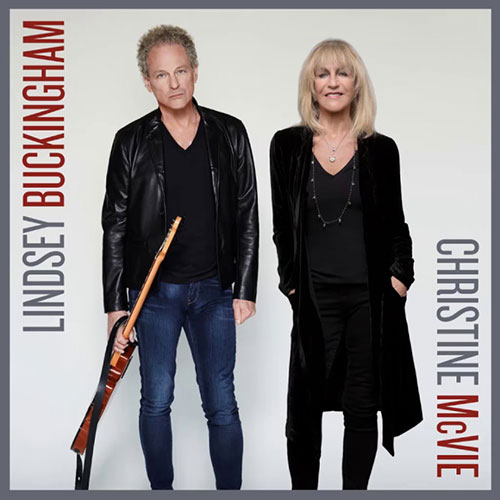
This is actually Fleetwood Mac without Stevie Nicks, who for some reason didn’t want to transport herself back to 1979 and the same studio the band used to record the Tusk LP. It’s Mick Fleetwood on drums, John McVie on bass, and a whole lotta throwback bubble-pop, which ranges from great (most of what Christine had a hand in, such as “Feel About You,” which steers toward the same lazy pants-itching longing as 1987’s “Everywhere” but without any truly absorbing counterpoint) to middling (kickoff tune “Sleeping around the Corner” sounds like something John Cougar would have tossed in the rubbish for being too vanilla). Nicks is sorely missing on “Red Sun,” an uninspired Crosby Stills and Nash-esque hippie humbug that could have been better if it were slightly underproduced. The CSN-soundalike problem surfaces a few times, including on “Love is Here to Stay,” which at least evinces that Buckingham is definitely into the whole trip, tabling some highbrow finger-picking that even an exuberant chorus fails to save.
Grade: B
Gucci Mane, DropTopWop (Atlantic Records)

This Atlanta rapper may have pioneered trap, but of course it was Baauer’s “Harlem Shake” that won the meme crown as well as the collective heart of the internet, with YouTuber Filthy Frank’s “pink guy” version alone now up to 58 million views at this writing. It wasn’t just luck (or the fact that he’s white), though; Baauer steered directly toward the EDM-trap crossover opportunity that presented itself and made way too many people forget that Gucci and all those other guys had blazed the trail. Gucci hasn’t done much this year, just an EP with Shawty Redd (3 for Free), a surprise being that he released a bunch of records while he was doing prison time on gun charges, and it’s a bit odd that the song celebrating his revived-BFF-age song with Nicki Minaj, “Make Love,” isn’t here. The snoozy Rick Ross collab (“Loss for Words”) is, though, as are visits from Chainz and Offset, etc., and the vocals aren’t delivered through a land line, so it counts as punching the clock. Bling, disses, drawling, the usual.
Grade: B
Poutine Aplenty
Poutine Aplenty
PoutineFest Returns to Manchester
Written By Angie Sykeny (asykeny@hippopress.com)
Images: Stock Photo
A taste of Quebec is coming to Manchester as the Franco-American Centre hosts its second annual New Hampshire PoutineFest on Saturday, June 24.
Eleven local restaurants, caterers and food trucks will serve a variety of traditional and inventive poutine dishes to hundreds of tasters at Northeast Delta Dental Stadium.
“Generally, poutine is gravy, cheese curds and french fries,” event coordinator Tim Beaulieu said. “However, it’s like pizza. It’s been Americanized. People put different spins on it and mix it with foods from other cultures, and here [at the festival], you have a chance to sample them all.”

Upon entry, tasters will receive passports with the vendors listed. They can get one three- to five-ounce sample from each vendor, getting their passports stamped as they go.
Many of the vendors will serve poutine made with the traditional ingredients, but with some variations when it comes to the style of fries and type of gravy and cheese curds.
“It’s like steak — everyone cooks it a little different,” Beaulieu said. “They can use chicken or beef [in the gravy] or they can do handcut fries, shoestring fries, sweet potato fries or even potato wedges.”
Other vendors will deviate from the traditional poutine and incorporate other ingredients and cuisine styles. There will be a vegetarian falafel poutine, pulled pork poutine, duck confit poutine, smoky maple poutine and more.
Many vendors will serve the same poutine they feature as a special or regular item on their menus.
“A lot of restaurants have it or are starting to do it,” Beaulieu said. “It’s something you’ll see on menus more and more.”
Vendors will also be competing for the title of Best Poutine of the Fest and the chance to raise the “Ceinture de Championnat” or Championship Belt. The winner will be determined by a panel of judges including Denny Corriveau “The Wild Cheff” and other poutine experts, and by the attendees’ votes.
The final hour of the festival will overlap with the New Hampshire Fisher Cats’ Franco-American Heritage Night baseball game, during which the players will wear “poutine jerseys” that will be raffled off after the game.
Beaulieu encourages people to relax, pace themselves and enjoy a beer or soda between tastings.
“There’s plenty of time, even if you want to try them all,” he said. “If you’ve never tried poutine, take this opportunity to try all the different types and get a feel for what kinds you like.”
NH PoutineFest
Where: Northeast Delta Dental Stadium, 1 Line Drive, Manchester
When: Saturday, June 24, 3:30 to 7 p.m.
Cost: $30 per person. Tickets are limited. Sales end June 18.
Visit: nhpoutinefest.com
Participating Vendors: Bar One, Chez Rafiki’s, Chez Vachon Restaurant, The Foundry, Grub, Kimball’s CAV’ern, Maudite Poutine, New England’s Tap House Grille, River Road Tavern , Vulgar Display of Poutine
Lobster, Hops & Pups
Lobster, Hops & Pups
British Beer Aims to Break Record for Longest Lobster Roll
Written By Kelly Sennott (ksennott@hippopress.com)
Images: Courtesy Photo
Celebrate Father’s Day with lobster, beer sampling and puppies at the LobHopster Fest in Portsmouth, where British Beer Co. is setting out to break the world record for longest lobster roll.
The event is happening from noon to 4 p.m. at Portwalk Place, and the highlight will be the 150-foot-long lobster roll filled with fresh New England lobster.
“We have our artisan bakery, Pain D’Avignon, from the Cape putting together some rolls for us and we’re going to piece them together to make one contiguous 150-foot sub roll,” said Jason Narinian, a director of operations at British Beer Co.
Two hundred pounds of coastal Maine cold water lobster meat will be mixed with mayonnaise, celery, lemon, sea salt, pepper and British Beer Co.’s signature Sympathy for the Devil hot sauce. This feast, despite its mass, will be prepared the morning of the event with a forecasted assembly time of just one hour.
Event-goers can get a piece of the football-field-sized lobster roll for a $10 donation — much more affordable than the whole roll would be, if it were for sale.
“If you get a 6-inch lobster roll, what do you usually pay — 20, 25 bucks? So, if you do 150 feet, that’s 300 lobster rolls, times $20, that’s $6,000,” Narinian said.

Brewery representatives serving samples inside British Beer Co. will include Allagash, Banded Horn, Paulaner, Guinness, Jack’s Abby, Stoneface, Tuckermans, 603, Shipyard, 2 Roads, Newburyport Brewing and more.
Beatles tribute band Walrus Gumboot will play throughout the event.
“The band will be set up inside; we’ll have all of the windows and doors open, so you should be able to hear it on the street,” Narinian said.
Giveaways from participating breweries and distributors will include T-shirts, hats and brewery trips.
Along with the event, British Beer Co. will be serving a menu of lobster-centered specials all weekend long.
“We’re going to do a lobster feature menu [that will] have lobster mac and cheese, lobster flatbreads, and whatever chef comes up with for a lobster menu. We’ll probably have 10 to 12 lobster dishes as our specials menu for that weekend,” Narinian said.
What else goes with lobster rolls and beer? Puppies, of course. Since proceeds from the LobHopster Fest will benefit the nonprofit organization Hero Pups, there will be about half a dozen puppies visiting the event.
“We’re going to bring some of the younger ones,” Hero Pups founder and president Laura Barker said. “It’s also a really good deal — you get part of a lobster roll, and all the beer and swag and puppy kisses and music for 10 bucks. What better Father’s Day gift can you have?”
Hero Pups aims to place therapy dogs with veterans and first responders.
“We were trying to figure out a way to really support people in the community who are going above and beyond to benefit veterans,” Narinian said. “We wanted to do something with law enforcement or veterans, and Hero Pups does a lot for both, so we thought it was a perfect fit for us and our community outreach,” said Narinian. “We wanted to support people that are supporting the community themselves.”
With the donations, they plan to buy new fencing for their dogs.
“Every cent we raise goes to caring for these dogs,” Barker said. “It’s more expensive to use rescues than it would be to use some breeder dogs, but it’s our philosophy that we can help both ends of the leash this way and save two lives at a time.”
LobHopster Fest
When: Sunday, June 18, noon to 4 p.m.
Where: British Beer Co. and Portwalk Place, Portsmouth
Admission: Free, lobster roll $10 donation

